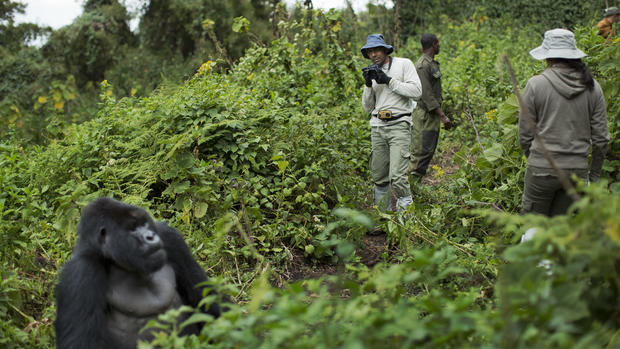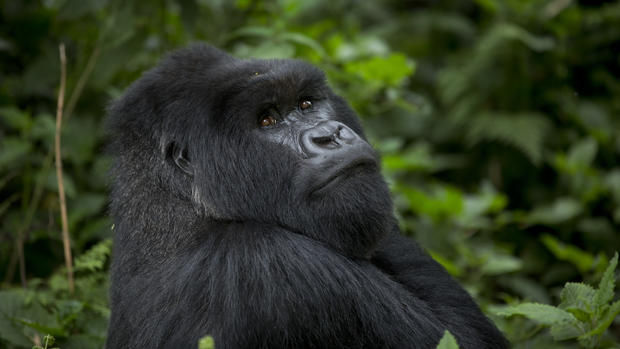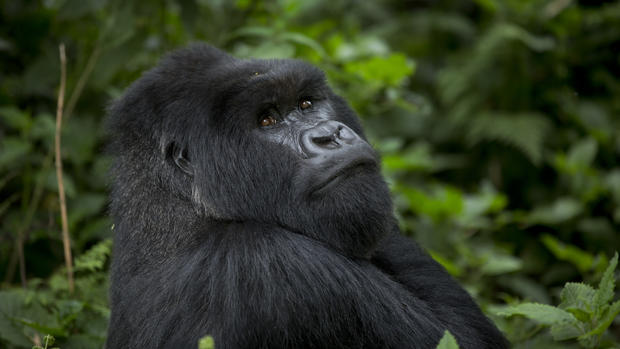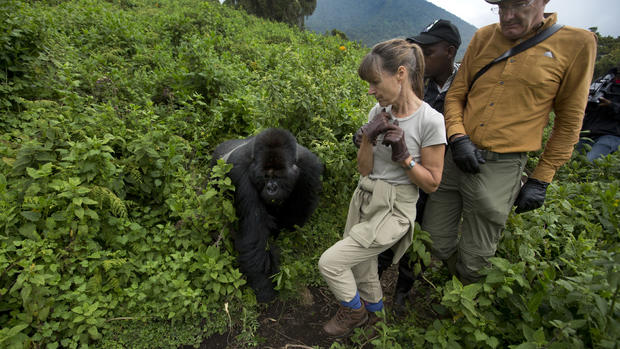Tourists get close, but not too close, to gorillas in Africa
JOHANNESBURG -- In some parts of Africa, tourists and researchers routinely trek into the undergrowth to see gorillas in their natural habitat. There are no barriers and no enclosures, and the apes, many of whom are accustomed to people, sometimes move past first-time visitors frozen in place, their awe mingling with apprehension.
This delicate interaction usually happens without incident, overseen by guides who brief trekkers on rules designed as much to protect infection-prone gorillas from humans as to shield humans from hulking wild animals. It's a very different situation to the tense, rapidly unfolding events on May 28 at the Cincinnati Zoo, where an animal response team shot and killed an endangered adult male gorilla named Harambe after a 3-year-old boy fell into an enclosure.
A key to studying gorillas in their habitats is to maintain a minimum distance and convey "a certain kind of feeling that they are not under too much pressure," Thomas Breuer, a researcher with the New York-based Wildlife Conservation Society, said in a telephone interview from the Republic of Congo.
Researchers today, Breuer said, don't practice the up-close methods of Dian Fossey, the American primatologist who won the confidence of gorillas by imitating their noises, moving on her knuckles and chewing on vegetation. Fossey, who brought international attention to the endangered primates' plight and whose book "Gorillas in the Mist" inspired a movie starring Sigourney Weaver, was murdered at her Rwandan research camp in 1985.
In Rwanda, guides who lead tourists to see habituated gorillas ask them to stay at least 23 feet away from the animals. They also say: Don't point, speak softly, don't cough or sneeze in the animals' direction and if a gorilla approaches, crouch down, don't make eye contact and make a low sound similar to that of clearing the throat, which gorillas use to express friendliness.
Tourists must be over 15 years old to be eligible for gorilla-trekking, according to Rwandan park officials.
The Cincinnati scenario was unpredictable. The zoo said it made a hard decision to kill the gorilla to ensure the child's safety. Video shows Harambe swiftly dragging the boy through the moat water, and also pausing and touching the child in a way that some people viewed as protective. Alarmed calls of onlookers can be heard.
Recordings were released of the frantic 911 calls made after the accident. Just moments after her little boy fell into the gorilla enclosure, the terrified mother called for help, CBS News' Jamie Yuccas reported.
"Hi. My son fell in the zoo exhibit at the gorillas," the woman said. "There's a male gorilla standing over him. I need someone to contact the zoo please."
"We do already have help started there, okay?" the dispatcher responded.
"Okay. Isaiah be calm! Be calm! Be calm! He's dragging my son. I can't watch this... I can't. I can't watch."
Others dialed 911 as they watched the 420-pound gorilla drag the boy throughout the exhibit.
"He is dragging him from one end to the other," one caller said. "Oh my God!"
Zookeepers killed the endangered western lowland gorilla to save the boy's life.
The Jane Goodall Institute released an email sent by the primatologist and conservationist to Thane Maynard, the director of the Cincinnati Zoo, expressing empathy with him over what she called the "devastating loss" of the gorilla. Goodall wrote that she feels sorry for Maynard having to defend a shooting that he "may disapprove of" and that it looked like the gorilla was putting an arm around the child.
Goodall, known for her decades of studying wild chimpanzees in Tanzania, also asked about the reaction of the other gorillas and whether they were allowed to express grief.
Dominant male gorillas like Harambe, known as silverbacks for their distinguishing hair color, can be more aggressive in limited spaces such as zoos than they would be in the wild, and can also seem uncharacteristically "inactive and stoic" while sitting in enclosures, said Eva Maria Luef, a researcher with the Max Planck Institute for Ornithology in Germany.
In the Republic of Congo, "we never had to be afraid of the silverbacks we were observing and they tolerated us humans (researchers and tourists) around them without ever showing any aggression," Luef wrote in an email to The Associated Press. "When humans treat the gorillas with respect and do not get too close or harass them in their 'private space,' gorillas are peaceful and friendly."
Harambe was a western lowland gorilla, the most populous of several endangered kinds of gorilla that live in African forests. The population of another kind, the Grauer's gorilla, plunged by 77 percent in the past 20 years to 3,800 because of illegal hunting, past civil unrest and loss of habitat, according to a report released in April by the Wildlife Conservation Society and Fauna & Flora International.
The outlook is positive if precarious for mountain gorillas, another endangered group whose population has increased to about 900 in the wild after a big decline in the past century. Many live in the Virunga Massif, which spans Rwanda's Volcanoes National Park as well as parks in neighboring Uganda and the Democratic Republic of Congo; the population there is growing at about 4 percent a year.
Last year, an AP team trekked to see gorillas in Rwanda. The 23-feet distance rule was difficult to follow because gorillas, which have close genetic links to humans, dropped out of trees and came up behind tourists on a trail, seemingly ignoring the visitors as they pushed past in silence.
"A tourist might feel conflicting impulses to shy away and reach for a hug (the latter is not advised) when a gorilla brushes past on a path. The way a gorilla snoozes, scratches a leg or casts an inquiring glance -- it all seems familiar, and yet wild," the AP reported.
Breuer has studied gorillas in Nouabalé-Ndoki National Park in the Republic of Congo in a project partly supported by the Cincinnati Zoo. He said a popular image of gorillas as "gentle giants" is misleading, and that experienced Congolese guides had occasionally stepped forward with raised sticks to ward off aggressive animals.
"These are not pets," Breuer said.




